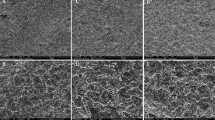Abstract
The results of the investigation of the proliferation effect on a mesenchymal stem cell (MSC) culture and the estimates on cytotoxicity of surfaces of titanium nickelide specimens prepared using special mechanical and electrochemical methods and characterized by different morphology and roughness are presented. The specimens of the alloy based on titanium nickelide are shown not to exert any toxic action on the MSCs of rats. When cultivated in the presence of the tested materials or being on their surfaces, MSCs preserved their viability, adhesive and morphological properties, and the ability for in vitro proliferation. This was confirmed by the following methods: cell counting in a Goryaev chamber, MTT, flow cytometry, and light and fluorescent microscopy. It was revealed that the proliferation processes are weakly pronounced on the surface of TH1(B) specimens whose C10–11 class roughness was achieved by multistage mechanical grinding to “high luster” and subsequent electrolytic grinding. On the contrary, the C7 class roughness of the TH1(A) specimen surfaces achieved by chemical etching and subsequent electrolytic grinding is more optimal for MSC proliferation.
Similar content being viewed by others
References
Abugov, S.A., Puretskii, M.V., Rudenko, P.A., et al., Results of Endovascular Stenting of Bifurcation Stenosises of Sicks with Heart Ishemic Illness, Kardiologiya, 1998, No. 8, pp. 7–11.
Arablinskii, A.V., Rogan, S.V., and Sidel’nikov, A.V., Stenting of Coronar Artery in Clinical Practice, Kardiologiya, 2000, No. 9, pp. 100–105.
Kornilov, I.I., Belousov, O.K., and Kachur, E.V., Nikelid titana i drugie splavy s effektom pamyati (Titanium Nickelide and Other Shape Memory Alloys), Moscow: Nauka, 1977.
Lotkov, A.I., Khachin, V.N., Grishkov, V.N., Meisner, L.L., and Sivokha, V.P., Shape Memory Alloys, in Fizicheskaya mezomekhanika i komp’yuternoe konstruirovanie materialov (Physical Mesomechanics and Computer Construction of Materials), Novosibirsk: Nauka, 1995, vol. 2, pp. 202–213.
Zhuravlev, V.N. and Pushin, V.G., Splavy s termomekhanicheskoi pamyat’yu i ikh primenenie v meditsine (Alloys with Thermomechanical Memory and Their Use in Medicine), Ekaterinburg: Ural. Otd. Ross. Akad. Nauk, 2000.
Meisner, L.L., Mechanical and Physico-Chemical Properties of Titanium Nickelide Based Alloys with Thin Surface Layers Modified by Charged Particle Flows, Fiz. Mezomekh., 2004, vol. 7,Sp. Number, part 2, pp. 169–172.
Lotkov, A.I., Meisner, L.L., and Grishkov, V.N., Titanium Nickelide-Based Alloys: Surface Modification with Ion Beams, Plasma Flows, and Chemical Treatment, Phys. Met. Metallogr., 2005, vol. 99, no. 5, pp. 508–519.
Williams, D., Biocompatibility of Clinical Implant Materials, Boca Raton: CRC Press, 1981.
Shabalovskaya, S.A., Anderegg, J., Laab, F., et al., Surface Conditions of Nitinol Wires, Tubing and As-Cast Alloys. The Effect of Chemical Etching, Aging in Boiling Water, and Heat Treatment, J. Biomed. Mater. Res., 2003, vol. 65, pp. 193–203.
Biosovmestimost’ (Biocompatibility), Sevast’yanov, V.I., Ed., Moscow: ITs VNII Geosistem, 1999.
Shakhov, V.P., Khlusov, I.A., Dambaev, G.S., et al., Methods of Cell Culture, Artificial Organs and Biomaterial Study, in: Vvedenie v metody kul’tury kletok, bioinzhenerii organov i tkanei (Introduction to the Cell Culture, Organ and Tissue Bioengineering Methods), Tomsk: STT, 2004.
Korzh, N.A., Kladchenko, L.A., and Malyshkina, S.V., Implantation Materials and Osteogenesis. Role of Optimization and Stimulation in Bone Reconstruction, Ortoped., Travmatol. Protezir., 2008, No. 4, pp. 5–14.
Vladimirskaya, E.V., Maiorova, O.A., Rumyantsev, S.A., and Rumyantsev, A.G., Stem Cells and Intercell Interactions, in Biologicheskie osnovy i perspektivy terapii stvolovymi kletkami (Biological Fundamentals and Perspectives of Therapy by Stem Cells), Moscow: Medpraktika, 2005.
Miller, D.C., Haberstroh, K.M., and Webster, T.J., PLGA Nanometer Surface Features Manipulate Fibronectin Interection for Improved Vascular Cell Adhesion, J. Biomed. Mater. Res., A, 2006, vol. 81, pp. 678–684.
Mosmann, T., Rapid Colorimetric Assay for Cellular Growth and Survival: Application to Proliferation and Cytotoxicity Assays, J. Immunol. Meth., 1983, vol. 65, pp. 55–63.
Tatarenko-Koz’mina, T.Yu., Poradovskaya, T.P., Kudinova, V.F., and Pavlova, T.E., Study of Mesenchymal Stromal Cells of Marrow-Predecessors of Osteoplasts on Biostable Composites, Sbornik nauchnykh rabot Sibirskogo gosudarstvennogo meditsinskogo universiteta “Estestvoznanie i gumanizm” (Collection of Scientific Papers of Siberian State Medical Univ. “Natural Science and Humanism”), Tomsk, 2005, vol. 2, part 2.
Plokhinskii, N.A., Biometriya (Biometry), Moscow: MGU, 1970.
Akimov, A.G., About Regularities of Protection Oxide Layers in Metal (Alloy)-Medium Systems, Zashchita Metallov, 1986, vol. 22, no. 6, pp. 879–886.
Meisner, L.L., Sivokha, V.P., Lotkov, A.I., and Barmina, E.G., Corrosion Properties of Quasibinary Section of TiNi-TiAu Alloys in Biochemical Solutions, Fiz. Khim. Obrab. Mater., 2006, no. 1, pp. 78–84.
Shabalovskaya, S.A., He, Tian., Andregg, J.W., et al., The Influence of Surface Oxides on the Distribution and Release of Nickel from Nitinol Wires, Biomaterials, 2009, vol. 30, no. 4, pp. 468–477.
Anselme, K., Osteoblast Adhesion on Biomaterials, Biomaterials, 2000, no. 21, pp. 667–681.
Eisenbarth, E., Linez, P., Biehl, V., et al., Cell Orientation and Cytoskeleton Organization on Ground Titanium Surfaces, Biomolecular Eng., 2002, vol. 19, nos. 2–6, pp. 233–237.
Pareta, R.A., Reising, A.B., Miller, et al., An Understanding of Enhanced Osteoblast Adhesion on Various Nanostructured Polymeric and Metallic Materials Prepared by Ionic Plasma Deposition, J. Biomed. Mater. Res., A, 2010, vol. 92, no. 3, pp. 1190–1201.
Marleta, J., Uptonac, J., Langerbo, R., and Vacantica, J.P., Transplantation of Cells in Matrices for Tissue Regeneration, Advan. Drag Delivery Rev., 1998, no. 3, pp. 165–182.
Miller, D.C., Haberstroh, R.M., and Webster, T.J., Mechanism(s) of Increased Vascular Cell Adhesion on Nanostructured Poly(lactic-co-glycolic acid) Films, J. Biomed. Mater. Res., A, 2005, vol. 73, pp. 476–484.
Author information
Authors and Affiliations
Corresponding author
Additional information
Original Russian Text © A.I. Lotkov, S.G. Psakh’e, L.L. Meisner, V.A. Matveeva, L.V. Artem’eva, S.N. Meisner, A.L. Matveev, 2011, published in Perspektivnye Materialy, 2011, No. 4, pp. 42–53.
Rights and permissions
About this article
Cite this article
Lotkov, A.I., Psakh’e, S.G., Meisner, L.L. et al. The effect of chemical composition and roughness of titanium nickelide surface on proliferative properties of mesenchymal stem cells. Inorg. Mater. Appl. Res. 3, 135–144 (2012). https://doi.org/10.1134/S2075113312020116
Published:
Issue Date:
DOI: https://doi.org/10.1134/S2075113312020116




